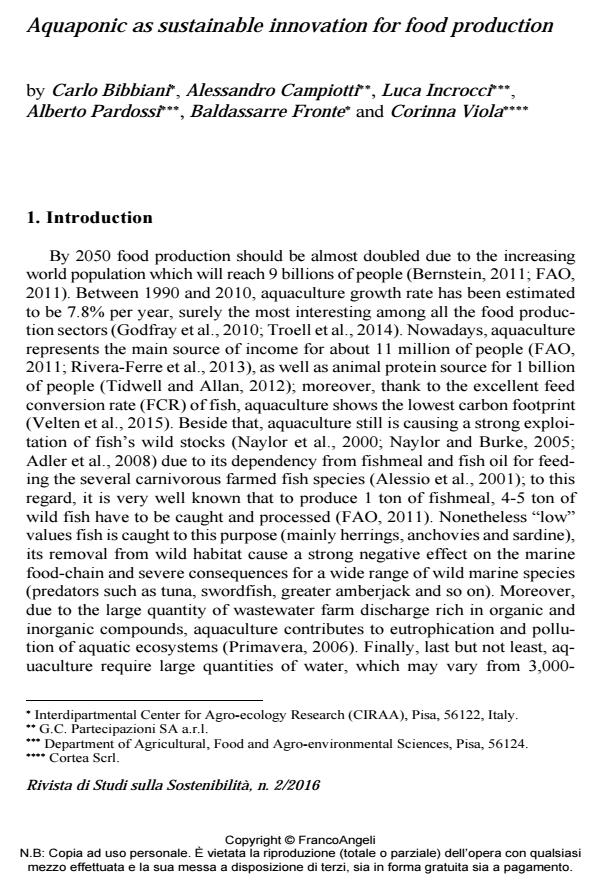Aquaponic as sustainable innovation for food production
Titolo Rivista RIVISTA DI STUDI SULLA SOSTENIBILITA'
Autori/Curatori Carlo Bibbiani, Alessandro Campiotti, Luca Incrocci, Alberto Pardossi, Baldassarre Fronte, Corinna Viola
Anno di pubblicazione 2017 Fascicolo 2016/2
Lingua Inglese Numero pagine 10 P. 249-258 Dimensione file 148 KB
DOI 10.3280/RISS2016-002022
Il DOI è il codice a barre della proprietà intellettuale: per saperne di più
clicca qui
Qui sotto puoi vedere in anteprima la prima pagina di questo articolo.
Se questo articolo ti interessa, lo puoi acquistare (e scaricare in formato pdf) seguendo le facili indicazioni per acquistare il download credit. Acquista Download Credits per scaricare questo Articolo in formato PDF

FrancoAngeli è membro della Publishers International Linking Association, Inc (PILA)associazione indipendente e non profit per facilitare (attraverso i servizi tecnologici implementati da CrossRef.org) l’accesso degli studiosi ai contenuti digitali nelle pubblicazioni professionali e scientifiche
To better understand aquaponic, it is important to describe the socio-demographic context and the role of agriculture in a future perspective. Due to the increasing world population, by 2050 food production should be increased of not less than 70%. Nowadays the agriculture sector is playing a key role in ensuring food security and in the upcoming context it should also face one of the greatest dilemmas of the modern age, which consist in producing more food using less resources and minimizing the environmental impacts. To cope with this challenge, the aquaculture technology seems to be one of the most suitable production systems able to face this dilemma. In this paper, the technical and technological aspects of the Integrated Aquaponic System (IAS) are described. The integration of an aquaponic system with algae, worms and insects production it is also suggested for improving sustainability.
Il sistema produttivo costituito dall’impresa produttiva dell’acquacoltura si configura di estremo interesse in termini di produzione di cibo soprattutto se consideriamo le prospettive socio-demografico che, sulla base di valutazioni FAO, vedono la popolazione entro il 2050 aumentare di una percentuale non inferiore al 70% rispetto alla popolazione attuale. Tale aumento demografico comporterà, secondo la FAO, la necessità di garantire la produzione di cibo senza, tuttavia, aumentare il prelievo di risorse naturali e l’emissione in atmosfera di gas ad effetto serra. L’acquacoltura, infatti, rappresenta uno dei comparti produttivi potenzialmente in grado di soddisfare l’aumento sostenibile delle richieste di cibo. Questo lavoro riporta una descrizione delle tecnologie che si riferiscono ai Sistemi di Acquacoltura Integrata (SAI) e descrive brevemente gli aspetti di produzione integrata tra l’acquacoltura, la produzione di alghe, vermi e insetti.
Parole chiave:Acquacoltura, sicurezza alimentare, agricoltura, sostenibilità.
- Preliminary study on eel breeding and vegetables production in an aquaponic system B. Fronte, L. Incrocci, G. Galliano, G. Carmassi, A. Pardossi, C. Bibbiani, in Acta Horticulturae /2021 pp.415
DOI: 10.17660/ActaHortic.2021.1305.54 - Sustainability of the rice-crayfish co-culture aquaculture model: microbiome profiles based on multi-kingdom analyses Xue Zhu, Lei Ji, Mingyue Cheng, Huimin Wei, Zhi Wang, Kang Ning, in Environmental Microbiome 27/2022
DOI: 10.1186/s40793-022-00422-4
Carlo Bibbiani, Alessandro Campiotti, Luca Incrocci, Alberto Pardossi, Baldassarre Fronte, Corinna Viola, Aquaponic as sustainable innovation for food production in "RIVISTA DI STUDI SULLA SOSTENIBILITA'" 2/2016, pp 249-258, DOI: 10.3280/RISS2016-002022